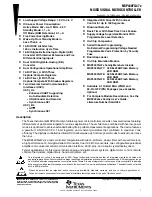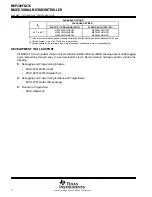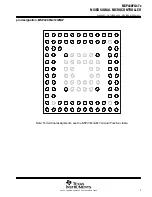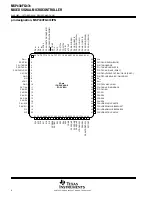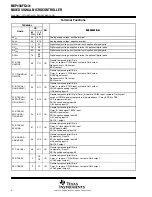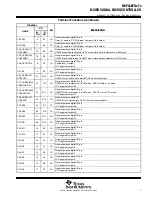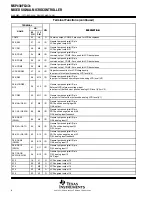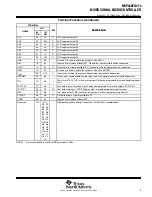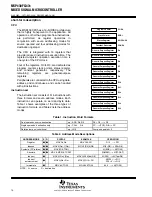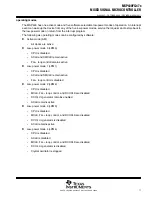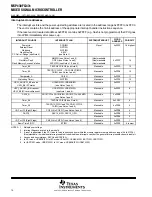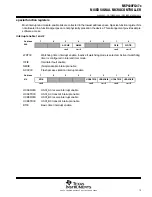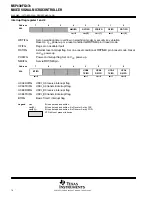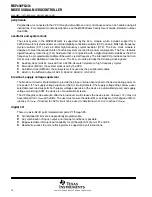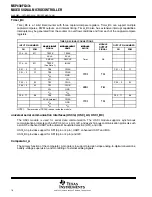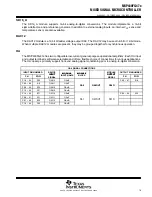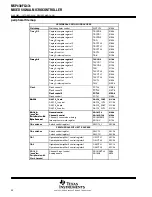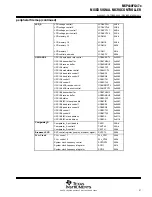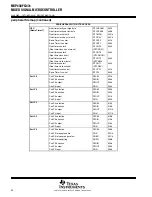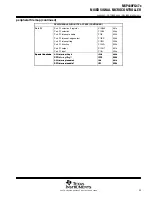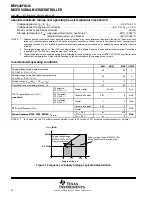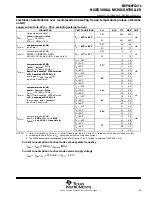
General-Purpose Register
Program Counter
Stack Pointer
Status Register
Constant Generator
General-Purpose Register
General-Purpose Register
General-Purpose Register
PC/R0
SP/R1
SR/CG1/R2
CG2/R3
R4
R5
R12
R13
General-Purpose Register
General-Purpose Register
R6
R7
General-Purpose Register
General-Purpose Register
R8
R9
General-Purpose Register
General-Purpose Register
R10
R11
General-Purpose Register
General-Purpose Register
R14
R15
MSP430FG47x
MIXED SIGNAL MICROCONTROLLER
SLAS580D -- OCTOBER 2008 -- REVISED MARCH 2011
10
POST OFFICE BOX 655303
DALLAS, TEXAS 75265
short-form description
CPU
The MSP430 CPU has a 16--bit RISC architecture
that is highly transparent to the application. All
operations, other than program-flow instructions,
are performed as register operations in
conjunction with seven addressing modes for
source operand and four addressing modes for
destination operand.
The CPU is integrated with 16 registers that
provide reduced instruction execution time. The
register-to-register operation execution time is
one cycle of the CPU clock.
Four of the registers, R0 to R3, are dedicated as
program counter, stack pointer, status register,
and constant generator, respectively. The
remaining
registers
are
general-purpose
registers.
Peripherals are connected to the CPU using data,
address, and control buses, and can be handled
with all instructions.
instruction set
The instruction set consists of 51 instructions with
three formats and seven address modes. Each
instruction can operate on word and byte data.
Table 1 shows examples of the three types of
instruction formats, and Table 2 lists the address
modes.
Table 1. Instruction Word Formats
Dual operands, source-destination
e.g., ADD R4,R5
R4 + R5 ------> R5
Single operands, destination only
e.g., CALL
R8
PC ---->(TOS), R8----> PC
Relative jump, un/conditional
e.g., JNE
Jump-on-equal bit = 0
Table 2. Address Mode Descriptions
ADDRESS MODE
S D
SYNTAX
EXAMPLE
OPERATION
Register
F F
MOV Rs,Rd
MOV R10,R11
R10 —> R11
Indexed
F F
MOV X(Rn),Y(Rm)
MOV 2(R5),6(R6)
M(2+R5)—> M(6+R6)
Symbolic (PC relative)
F F
MOV EDE,TONI
M(EDE) —> M(TONI)
Absolute
F F
MOV & MEM, & TCDAT
M(MEM) —> M(TCDAT)
Indirect
F
MOV @Rn,Y(Rm)
MOV @R10,Tab(R6)
M(R10) —> M(Tab+R6)
Indirect
autoincrement
F
MOV @Rn+,Rm
MOV @R10+,R11
M(R10) —> R11
R10 + 2—> R10
Immediate
F
MOV #X,TONI
MOV #45,TONI
#45 —> M(TONI)
NOTE: S = source
D = destination
Summary of Contents for MSP430FG47x
Page 91: ......

